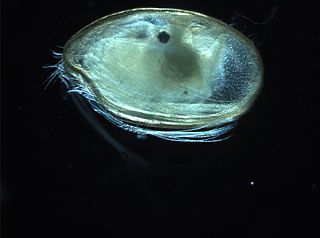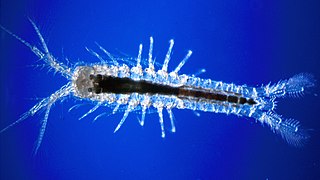
Remipedia is a class of blind crustaceans, closely related to hexapods, found in coastal aquifers which contain saline groundwater, with populations identified in almost every ocean basin so far explored, including in Australia, the Caribbean Sea, and the Atlantic Ocean. The first described remipede was the fossil Tesnusocaris goldichi. Since 1979, at least seventeen living species have been identified in subtropical regions around the world.

Ostracods, or ostracodes, are a class of the Crustacea, sometimes known as seed shrimp. Some 33,000 species have been identified, grouped into 7 valid orders. They are small crustaceans, typically around 1 mm (0.04 in) in size, but varying from 0.2 to 30 mm in the case of the marine Gigantocypris. The largest known freshwater species is Megalocypris princeps, which reach 8mm in length. In most cases, their bodies are flattened from side to side and protected by a bivalve-like valve or "shell" made of chitin, and often calcium carbonate. The family Entocytheridae and many planktonic forms do not have calcium carbonate. The hinge of the two valves is in the upper (dorsal) region of the body. Ostracods are grouped together based on shell and soft part morphology. While early work indicated the group may not be monophyletic and early molecular phylogeny was ambiguous on this front, recent combined analyses of molecular and morphological data suggested monophyly in analyses with broadest taxon sampling, but this monophyly had no or very little support. They have a wide range of diets, and the class includes carnivores, herbivores, scavengers and filter feeders, but most ostracods are deposit feeders.

The Myodocopida is one of the two orders within the Myodocopa, in turn a subclass of the Ostracoda. The Myodocopida are distinguished by a worm-like seventh limb, and, usually, a rostrum above an incisure (notch) from which the antennae can protrude. Unlike other ostracods, many species of the Myodocopida have lateral compound eyes Over the last thirty years there has been much research into the morphology, behaviour and distribution of myodocopids. More recently, DNA sequences have been used to investigate the phylogeny of various groups.

Cylindroleberididae is a family of ostracods that shows remarkable morphological diversity. The defining feature is the possession of gills: 7–8 leaf-like pairs at the posterior of the body. Other features common to all species in the family include a "baleen-comb" on both the maxilla and the fifth limb, a sword-shaped coxal endite on the mandible, and the triaenid bristles on the basal endites of the mandible.
Collared wrigglers are perciform fishes in the family Xenisthmidae. They are native to the Indian and Pacific Oceans, where they are mostly reef-dwelling.
The New Caledonian gallinule was a species of bird in the family Rallidae. It was endemic to New Caledonia and probably became extinct due to hunting, habitat loss and the presence of invasive species following human settlement of the island. However a passage from an 1860 article refers to birds the size of turkeys being present in marshy areas of New Caledone, suggesting that it may have survived into historic times. The native name n'dino is thought to refer to this bird.

Aeretes is a genus of squirrels that contains a single extant species, the groove-toothed flying squirrel (Aeretes melanopterus).
Cambarus subterraneus, the Delaware County cave crayfish, is a species of crayfish in the family Cambaridae. It has been found only in three caves in Delaware County, Oklahoma.

Mictocaris halope is the only species of cave crustacean in the monotypic genus Mictocaris. It is placed in its own family, Mictocarididae, and is sometimes considered the only member of the order Mictacea. Mictocaris is endemic to anchialine caves in Bermuda, and grows up to 3.5 mm (0.14 in) long. Its biology is poorly known.
Richard Charles Froeschner was an American entomologist. He was born in Chicago, Illinois. He married Elsie Herbold Froeschner, a scientific illustrator, on October 6, 1940. He attended the University of Missouri in Columbia, Missouri.

The Processidae are a family of shrimp, comprising 65 species in five genera, and the only family in the superfamily Processoidea. They are small, nocturnal animals, mostly living in shallow seas, particularly on grass flats. The first pereiopods are usually asymmetrical, with a claw on one, but not the other. The rostrum is generally a simple projection from the front of the carapace, with two teeth, one at the tip, and one further back.
The Kanaka pigeon, also known as the great green pigeon or greater maned pigeon, is an extinct species of pigeon. It was probably hunted to extinction by the early settlers of New Caledonia and Tonga around 2,500 years ago. It was described from subfossil remains found at the Pindai Caves of New Caledonia. The specific epithet is a Latinisation of kanaka, the name of the native Melanesian people of New Caledonia. It was about 25% larger than its closest living relative, the Nicobar pigeon.

Canace nascia is a European species of Canacidae.
The Pindai Caves of New Caledonia are an archaeological and palaeontological site important for the study of prehistoric human settlement as well as of the Holocene fauna of the island. The Pindai area has been occupied by humans for varying periods over the last 2,800 years.
The powerful goshawk, also referred to as the greater New Caledonian goshawk, is an extinct species of bird of prey in the family Accipitridae. It was endemic to the island of New Caledonia in Melanesia in the southwest Pacific region. It was described from subfossil bones found at the Pindai Caves paleontological site on the west coast of Grande Terre. The Latin specific epithet efficax means "powerful".
The gracile goshawk is an extinct species of bird of prey in the family Accipitridae. It was endemic to the island of New Caledonia in Melanesia in the southwest Pacific region. It was described from subfossil bones found at the Pindai Caves paleontological site on the west coast of Grande Terre. The Latin specific epithet quartus means "fourth"; it was the fourth Accipiter species recorded from New Caledonia. The gracile goshawk was smaller and much less robust than its contemporary congener the powerful goshawk, remains of which were also found at the same site.
The New Caledonian ground dove is a large, extinct species of Pampusana ground dove in the pigeon family, and the largest member of its genus. It was endemic to the island of New Caledonia in Melanesia in the south-west Pacific region. It was described from subfossil bones found at the Pindai Caves paleontological site on the west coast of Grande Terre. The specific epithet refers to the slender and elongated tarsometatarsus, or lower leg bone, of the species.

Baalzebub is a genus of ray spiders first described by Jonathan A. Coddington in 1986. Spiders in this genus typically live in dark environments, like caves.
Histioteuthis meleagroteuthis is a species of small to medium squids that have a dark, wine red skin pigment. Females at maturity average at 114mm in length, while males at maturity average at 65-102mm in length. This species is characterized by tubercles, photophores, and asymmetric features. This species can be found in circumglobal, mesopelagic waters.
An anchialine system is a landlocked body of water with a subterranean connection to the ocean. Depending on its formation, these systems can exist in one of two primary forms: pools or caves. The primary differentiating characteristics between pools and caves is the availability of light; cave systems are generally aphotic while pools are euphotic. The difference in light availability has a large influence on the biology of a given system. Anchialine systems are a feature of coastal aquifers which are density stratified, with water near the surface being fresh or brackish, and saline water intruding from the coast at depth. Depending on the site, it is sometimes possible to access the deeper saline water directly in the anchialine pool, or sometimes it may be accessible by cave diving.







